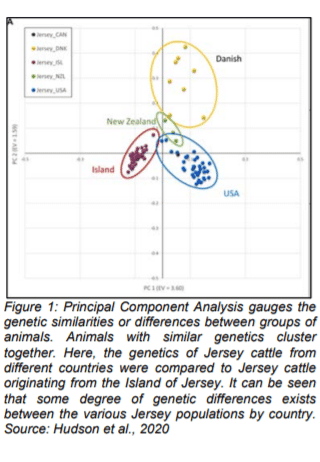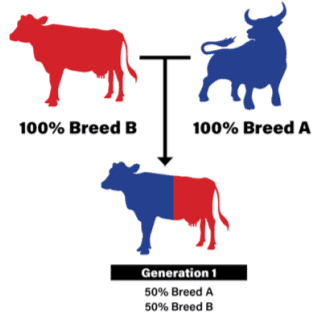 The ancestry of all registered dairy cattle can be traced back to the origin of each breed’s herdbook. For Jerseys this is the Island of Jersey, for Ayrshires the County of Ayr in Scotland, for Guernsey the Island of Guernsey, and for Holsteins the Dutch provinces of Northland and Friesland. While we have continued to select for the favourable characteristics within each breed that make them unique, there has been some interest in crossbreeding dairy animals which also raises questions regarding the definition of a “purebred” animal. Let’s take a look at an interesting case study to help us better understand what defines a breed – the Jersey herdbook on the Island of Jersey.
The ancestry of all registered dairy cattle can be traced back to the origin of each breed’s herdbook. For Jerseys this is the Island of Jersey, for Ayrshires the County of Ayr in Scotland, for Guernsey the Island of Guernsey, and for Holsteins the Dutch provinces of Northland and Friesland. While we have continued to select for the favourable characteristics within each breed that make them unique, there has been some interest in crossbreeding dairy animals which also raises questions regarding the definition of a “purebred” animal. Let’s take a look at an interesting case study to help us better understand what defines a breed – the Jersey herdbook on the Island of Jersey.
While the importation of livestock to the Island of Jersey was strictly prohibited, Jersey cattle from the Island have been exported around the world for the last two centuries. In 2008, after 219 years of isolation, the Island of Jersey opened its doors to international Jersey genetics with the goal of closing the performance gap between the island’s cattle and their international relatives. Although the change
in regulations came with hesitation and required parliamentary action, results from a recent study confirm that any risk is far outweighed by the benefit to slightly opening the Island of Jersey herdbook.
How is Breed Purity Determined?
In the case of the Island of Jersey, the benefits far outweighed any possible negative effects of introducing foreign genetics. The Island of Jersey population had a significantly higher level of inbreeding than the international populations, which was expected as the United States alone has over 90 times the number of Jersey cattle as on the Island. This emphasizes the importance of opening breed registries to include animals that foster the characteristics of the foundation breed. However, researchers need to be certain that the foundation of the breed, and the key characteristics that define cattle of that breed, are being preserved.
 Researchers use a tool called Principal Component Analysis (PCA) to measure the level of genetic similarities or differences between groups of animals. This type of analysis was done recently on the international and local Jersey cattle on the Island of Jersey. Figure 1 shows the results of the PCA when we compare all Jersey animals from various countries. You can see distinct groups or clusters ‐ signifying there are genetic differences between the groups of animals. This result was expected since the Island animals were isolated for
Researchers use a tool called Principal Component Analysis (PCA) to measure the level of genetic similarities or differences between groups of animals. This type of analysis was done recently on the international and local Jersey cattle on the Island of Jersey. Figure 1 shows the results of the PCA when we compare all Jersey animals from various countries. You can see distinct groups or clusters ‐ signifying there are genetic differences between the groups of animals. This result was expected since the Island animals were isolated for
over 200 years.
However, the differences observed in Figure 1 are relatively small compared to the differences between all Jersey animals, both Island and international, and other cattle breeds. In Figure 2, we see that Jersey animals cluster together and that large genetic differences clearly exist between the Jersey populations and cattle of other breeds. So, while the international Jerseys are not genetically identical to their Island ancestors, they contain much more similar genetic structures than that of other breeds.
These are the same results we would expect for other breeds, as well as with crossbreeding programs where the goal is to use animals from another breed to increase genetic diversity and then continue breeding back to the foundation breed. The final PCA would return a single, tight‐knit cluster showing that the resulting animals primarily contain the genetic structure of the foundation breed.
 What is Crossbreeding?
What is Crossbreeding?
Crossbreeding is a mating strategy that involves the mating of animals from two or more breeds that have complementary characteristics. It is more commonly used in terminal breeding programs, such as in the meat industry, where the majority of offspring do not enter the breeding herd. In crossbreeding programs, the goal is to take advantage of the different groups of genes that each breed has to offer. An additional benefit of such programs is the increase in genetic diversity and the associated lowering of inbreeding. When two animals of different breeds are mated, we maximize hybrid vigour or heterosis. These terms are used to describe the improved performance of crossbred animals due to the introduction of “new” genes from each purebred parent. After generations of mating back to the foundation breed, this hybrid vigour is lost. Eventually, the offspring produced generations later are almost genetically identical to the original foundation breed. The key question, however, is “When can they be considered a purebred?”
What Defines Breed Purity?
The Government of Canada Animal Pedigree Act of 1985 states that: “No association may, by its by‐laws, determine that an animal is a purebred of a distinct breed if the animal has less than seven‐eighths of its inheritance from the foundation stock of the animal’s breed or from animals previously registered as purebreds by the association.” This means that an animal must have at least 87.5% of its DNA from the foundation breed, or from other animals previously deemed as purebreds to be identified as purebred in a Canadian breed association’s herdbook registry.
 Estimating Breed Composition
Estimating Breed Composition
While this 1985 definition of the minimum standard for purebred status is helpful, it is now possible to use DNA genotypes to be more precise in measuring an animal’s breed purity. In the United States, as part of its routine genetic evaluation services the Council for Dairy Cattle Breeding (CDCB) also publishes a value for each animal referred to as the Breed Base Representation (BBR). The BBR was introduced to provide the means for calculating genomic evaluations for genotyped crossbred animals. The basis of the BBR calculation is a specific set of genetic markers (i.e.: SNP) that were found to be unique to known multi‐generational purebred animals within each breed. Using these markers, CDCB can estimate how much of an animal’s DNA is from each of the main breeds of cattle, which therefore defines their breed composition. By chance, an animal with known purebred ancestry may have a calculated BBR as low as 94%. Considering this potential range in calculated BBR values, the CDCB considers animals with a BBR of 94% or higher as purebred and
therefore do not treat them as crossbred animals for the calculation and publication of genomic evaluations. As shown in the sidebar diagram, after the first mating of two animals from different breeds, which results in a breed purity level of 50%, three more generations of mating back a purebred sire of the foundation breed results in offspring that have a breed purity level of 93.75%. Using the “purebred” policy in United States as a guiding principle, offspring resulting from five or more generations of mating back to purebred sires would be considered as purebreds.
“Breed Purity” Value Planned for Canada
While the use of crossbreeding in dairy cattle breeds is not as common in Canada compared to the United States, the dairy cattle industry has been requesting Lactanet to implement minimum standards associated with breed purity. Two examples include (a) the eligibility of bulls, cows and heifers to appear on lists of top ranked animals in each breed based on LPI, Pro$ or any individual trait, and (b) the calculation of BCA values for lactation records and to qualify for inclusion in production herd averages and/or awards. For these reasons, during 2022 Lactanet will be developing a new “Breed Purity” calculation algorithm to be applied in a fair and consistent manner across all dairy cattle breeds in Canada. This same Breed Purity percentage value will be available to the various national breed associations for the application of herdbook registry rules and policies.
Authors: Caeli Richardson, KTT Genetics Expert
Brian Van Doormaal, Chief Services Officer
Source: CDN/Lactanet




